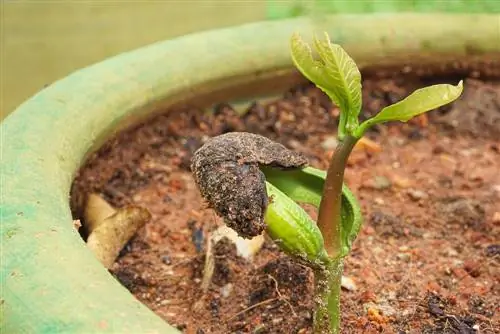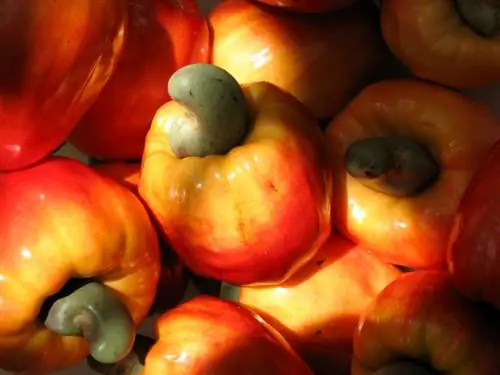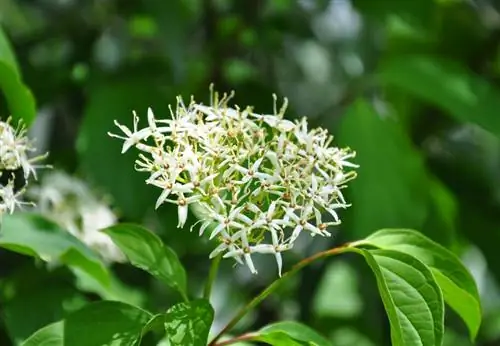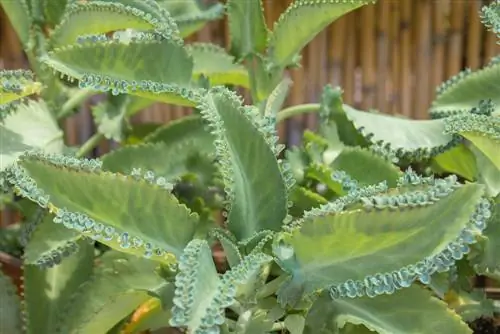- Author admin [email protected].
- Public 2023-12-16 16:46.
- Last modified 2025-01-23 11:22.
Read a commented cashew tree profile here with information about growth, cashew fruit and cashew nuts. Many tips and tricks explain how to grow a cashew tree from seeds, plant it correctly and care for it.
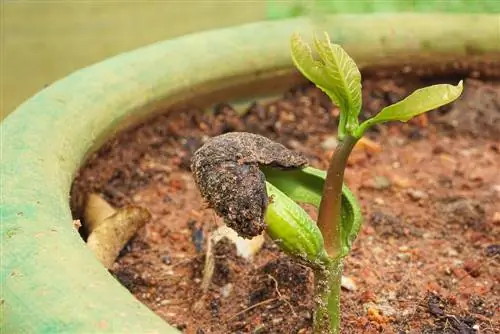
What is a cashew tree and how can you care for it in Germany?
The cashew tree (Anacardium occidentale) is a tropical, evergreen deciduous tree grown for its tasty cashews. In Germany it can be cultivated as a decorative pot plant, but requires careful care, ideal temperatures and high humidity in order to grow he althily and bear fruit.
Profile
- Scientific name: Anacardium occidentale
- Family: Sumac family (Anacardiaceae)
- Synonyms: cashew tree, kidney tree
- Occurrence: Tropics
- Growth type: deciduous tree
- Growth habit: broad-crowned
- Growth height: 10 m to 12 m
- Leaf: obovate, evergreen
- Flower: panicle
- Fruit: Drupe
- Root: taproot
- Winter hardiness: sensitive to frost
Growth
Where do cashews grow? The cashew tree is an evergreen deciduous tree with high economic value in its tropical home regions. Anacardium occidentale is primarily grown for its tasty, kidney-shaped seeds. Cashew nuts are a popular snack in this country. Hobby gardeners in German-speaking countries appreciate the exotic cashew tree as a decorative potted plant that, if cared for well, allows them to produce their own harvest of crunchy cashew nuts. A look at the following characteristics of growth provides revealing details:
- Growth type: evergreen, tropical deciduous tree with yellowish-pink flower spikes, edible fruits and seeds.
- Growth habit: broad-crowned, sprawling, richly branched crown.
- Growth height in the habitat: 10 m to 12 m
- Growth height as a potted plant: 2 m to 3 m
- Root system: Taproot with extensive lateral roots.
- Ghorticulturally interesting properties: moderate to demanding care, requires warmth, tolerates cutting, non-toxic, no second cashew plant required for pollination.
Excursus
Largest cashew tree in the world
The largest cashew tree in the world can even be seen from space. Satellite images show the giant tree in the middle of a residential area in Brazil. The legendary kidney tree has been growing tirelessly there since the end of the 19th century. Its crown now covers an area of 8,500 m². The following video invites you to a virtual visit to the Pirangi cashew tree:
Bloom
Prologue for a rich cashew harvest is the summer flowering period with these flower properties:
- Inflorescence: long-stemmed, 20 cm to 25 cm long panicle with numerous, fragrant individual flowers.
- Single flower: fivefold, hairy (5 ovoid sepals, 5 elongated, recurved petals.
- Flower color: greenish-yellow to reddish.
- Flower ecology: andromonoceous (male or female and hermaphrodite flowers are located on a tree).
- Pollination: bees, flies, wind.
Fruit
If you are familiar with these fruit properties, will you know the correct answer to the question: How do cashew nuts grow?
- Fruit type: single-seeded drupe.
- Fruit shape: 5 cm to 10 cm long, thickened, pepper-shaped fruit stalk (cashew apple), from which a 2 cm small, kidney-shaped structure hangs (cashew fruit).
- Fruit color: Cashew apple with yellow-orange-red skin, drupe with greenish-brown skin.
The cashew apple is a false fruit whose seedless pulp is suitable for consumption. The actual, reproductive cashew fruit is the boxer glove-like appendage on the thickened fruit stalk, popularly known as the elephant louse with a wink. Inside are the edible seeds known as cashew nuts or cashews.
Cashews
Cashew nuts delight gourmets all over the world with their mild, sweet and nutty taste. The kidney-shaped kernels are often roasted, s alted or eaten raw. These valuable ingredients make cashew nuts a he althy snack for the whole family:
| Nutritional values | 100 g dry roasted seeds |
|---|---|
| Condensing value | 574 kcal (2402 kJ) |
| Fat | 46, 4 g |
| Carbohydrates | 32, 7 g |
| Protein | 15, 3 g |
| Fiber | 3 g |
| Potassium | 565 mg |
| Magnesium | 260 mg |
| calcium | 45 mg |
| Iron | 6 mg |
Detail worth knowing: With a content of 238 mg of the amino acid tryptophan per 100 g, cashews stimulate the production of the neurotransmitter serotonin. For this reason, eating the delicious nuts puts you in a good mood. The only downside is the poisonous shell that covers each cashew seed. Since raw cashews are also slightly poisonous, the nuts are only sold peeled and roasted.
Leaf
The richly branched crown of a cashew tree bears evergreen leaves with these characteristics:
- Leaf shape: obovate, entire margins, rounded to blunt, sometimes slightly indented.
- Leaf size: 8 cm to 15 cm long, 6 cm to 12 cm wide.
- Leaf color: leathery-green, evergreen, clearly visible leaf veins.
- Arrangement: alternate
Planting a cashew tree
You can only buy a ready-to-plant cashew tree in Germany sporadically. Anyone who finds what they are looking for, for example at flora-toskana.com, pays around 20 euros for an 18 cm to 20 cm small specimen. Planting after sowing cashew seeds is cheaper and offers a gardening experience. These planting tips explain how and where to properly plant a kidney tree:
Sowing
Commercially available cashews are not suitable as seeds. Immediately after harvest, the peeled seeds are roasted and are not able to germinate. You can buy certified cashew seeds from specialist retailers for around 1 euro per kernel. The following instructions explain step by step how to grow a cashew tree yourself from kernels:
- Sow cashew seeds no later than 6 weeks after receipt.
- Roughen the seed coat with fine sandpaper or a nail file.
- Soak the seeds in room temperature water for 12 to 24 hours.
- Fill a cultivation pot for each core with a mix of sowing substrate, unfertilized coconut soil and lava granules.
- Place the soaked seed halfway into the soil (indentation faces downwards, seed bulge is exposed).
- Moisten the substrate and seeds with a fine spray of soft water.
- Place seed pots in the heated indoor greenhouse.
- Keep slightly moist in a bright window seat at a constant 28° Celsius.
Under ideal conditions, the germination time takes four to six weeks. Cashew seedlings are further cultivated at cooler temperatures of 18° to 22° Celsius.
Planting
These tips and tricks explain what is really important when planting cashew trees:
- The bucket is deeper than it is wide so that the taproot can develop undisturbed.
- Drainage made of pottery shards on the bottom of the bucket prevents waterlogging.
- Optimal culture substrate: premium pot plant soil without peat, fertilized coconut soil as a peat substitute, lava granules or expanded clay and coarse sand.
- A lukewarm water bath prepares the root ball for planting.
- The planting depth in the bucket corresponds to the planting depth in the nursery pot or purchase container.
Location
The ideal location for a cashew tree as a potted plant simulates tropical conditions:
- Sunny, bright to partially shaded location with high humidity.
- From spring to autumn with temperatures starting at 20° Celsius.
- In winter at normal room temperatures around 18° Celsius.
- Temperature minimum: 15° Celsius
Recommended locations include heated winter gardens and light-flooded living and work spaces. In contrast to most tropical potted plants, the summer balcony is not suitable for a cashew tree.
Care for cashew tree
A cashew tree is moderately difficult to demanding to care for. The water supply requires sensitivity. A good sense of proportion is desirable when it comes to nutrient supply. If wintering is inadequate, the kidney tree indignantly throws off its evergreen leaves. In comparison, pruning care is child's play. The following care tips explain details worth knowing:
Pouring
- Maintain uniform soil moisture all year round without waterlogging or drought stress.
- Watering water quality: warmed, room temperature, filtered rainwater or decalcified tap water.
- Spray evergreen leaves regularly with soft, lukewarm water.
Fertilize
- Fertilize the cashew tree every 14 days from April to September with a liquid fertilizer for tropical potted plants.
- Do not fertilize a cashew plant that has been weakened by diseases, pests or care errors.
- Water with clear water before and after fertilizing.
Wintering
- Cashew tree overwinter bright and warm at an ideal 18° Celsius.
- Maintain uniform soil moisture by adjusting the watering frequency to the winter conditions.
- Do not fertilize from October to March.
Cutting
- Do not cut the cashew tree in the first few years.
- If necessary, remove wilted flowers, fruit mummies and dead leaves from the treetop in spring.
- Occasionally thin out older treetops in February or March.
- Extra tip: you can cut back individual, extra-long branches that protrude from the crown at any time.
Repotting
As a container plant, a cashew tree grows much slower than in its tropical home regions. Every two to three years you should repot the cashew tree into a larger pot with fresh soil. The best time is in early spring, shortly before the fresh shoots begin.
Diseases, pests, care errors
Far from its tropical home, a cashew tree is not immune to diseases and pests. Neglects in care can also weaken a cashew tree. The following table draws attention to common malfunctions, lists typical causes and refers to effective countermeasures:
| malicious image | Cause | Countermeasure |
|---|---|---|
| Shedding of leaves in winter | Lack of light | illuminate with daylight lamp |
| Brown leaf tips | room air too dry | Set up humidifier, spray leaves |
| Brown leaves, curled leaf edges | Drought stress | Dip root balls, water more often |
| Floppy branches, foul smell | Waterlogging | repotting, watering more sparingly |
| White webs | Spider mites | Shower off the crown, fight with soap and alcohol solution |
| Brown leaf bumps | Scale insects | wipe with alcohol-soaked cloth |
It is important to note that you do not fertilize a damaged cashew tree until it has recovered. Otherwise, unused fertilizer s alts will accumulate in the substrate and cause irreversible damage to the sensitive taproots.
Popular varieties
There are no cashew tree varieties available in Europe beyond the original species Anacardium occidentale.
FAQ
Are cashews poisonous?
Freshly harvested cashews are slightly poisonous and not suitable for consumption. The peel contains anacardic acid, a toxic oil that causes painful skin irritation. Furthermore, raw kernels contain various substances that are harmful to he alth. Steam treatment at high temperatures allows the hard shell to open and dissolves the toxins in the core. For this reason, you can only buy shelled and roasted cashews in grocery stores. Untreated, raw cashews are only used as seeds.
How is a cashew tree pollinated as a container plant?
In the tropics, bees, flies and ants take care of the pollination of a cashew plant. Hobby gardeners take on this task in closed living spaces, greenhouses and winter gardens. Use a soft bristle brush to stroke each flower to transfer pollen from the male flowers to the female and hermaphrodite flowers.
Where can you buy a cashew tree?
Purchasing sources for a ready-to-plant cashew tree are few and far between. We looked around the German-speaking area for you and found these providers: flora-toskana.com with a well-stocked online shop and on-site sales in Kempten. On Amazon, the German specialist retailer greenfuture plants trade occasionally offers cashew plants, either as a 5-10 cm small seedling or a 15-20 cm large young plant.

